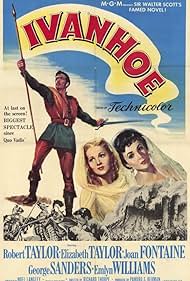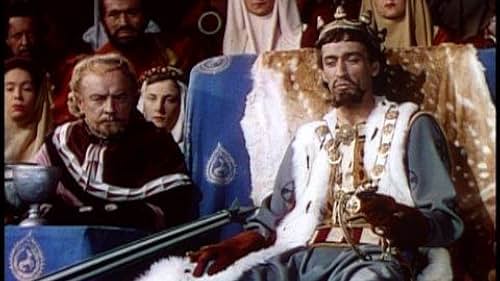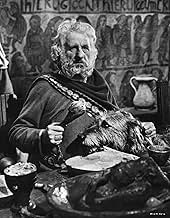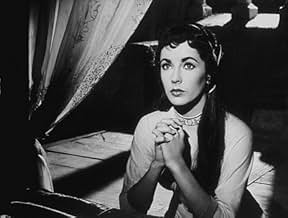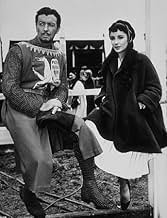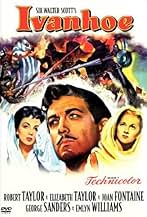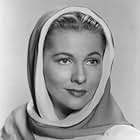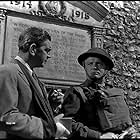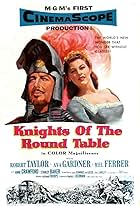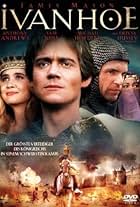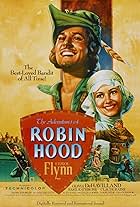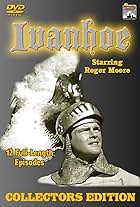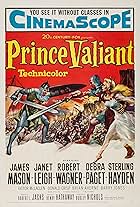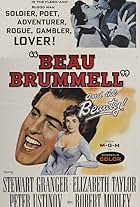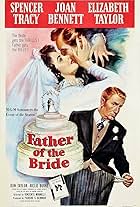A knight seeks to free the captive King Richard and put him back on the throne.A knight seeks to free the captive King Richard and put him back on the throne.A knight seeks to free the captive King Richard and put him back on the throne.
- Nominated for 3 Oscars
- 7 nominations total
Francis De Wolff
- Front De Boeuf
- (as Francis DeWolff)
Storyline
Did you know
- TriviaAt the beginning, Sir Wilfred of Ivanhoe is looking for King Richard I by singing until he finds the King. This is historically accurate, with the exception that the singer was a minstrel called Blondel. When Leopold of Austria captured King Richard I, Blondel went around to all of the castles singing King Richard's favorite song. (One story had it that King Richard actually co-wrote the song.) When he heard King Richard join in the chorus, he went home and told the Normans where King Richard was.
- GoofsCharacters are shown eating turkey during the feast in Ivanhoe's father's hall. Turkeys are indigenous to North America and were not known in England in the 12th century.
- Quotes
Rebecca: My heart is breaking, Father.
Isaac of York: My heart broke long ago. But it serves me still.
- ConnectionsEdited into Hollywood: The Dream Factory (1972)
- SoundtracksThe Song of Ivanhoe
(1952) (uncredited)
Music by Miklós Rózsa
Lyrics by Marguerite Roberts
Sung by Robert Taylor and Norman Wooland
Featured review
The difficulty with bringing a piece of revered literature to the big screen has more to do with pleasing the fans of the work than in making a pleasing movie. Those who hold Walter Scott's classic "Ivanhoe" in high esteem will deem any adaptation to a largely visual medium unworthy no matter how much care and devotion are given to visualizing the original source.
This version of "Ivanhoe" holds up well and remains one of the more realistic films dealing with the myth, legends, and pomp of the High Middle Ages. The pictorial representation of Judaism at a time of wide-spread persecution of that religion throughout Europe by Christians who continually used the Jews as scapegoats was noble indeed for 1952, the height of the McCarthy witch hunts. The audience of the day undoubtedly overlooked this point when Rebecca is accused of witchcraft in order to insure conformity and stifle opposition to Prince John's tyrannical rule of England in King Richard's absence.
From a historical perspective, this film is about as accurate as any of the numerous Robin Hood tales prevalent at the time in the movies and on TV. Ivanhoe's father is correct when he remarks that Richard would be no better than John as far as the Saxons were concerned. Both Richard and John were ineffectual rulers. Prince John (later King John) has received a bad press as a result of the lionization of Richard the Lionheart. At least John stayed home and attempted to rule England; whereas, Richard was always traipsing about Europe and the Near East on a Crusade or leading his knights in battle mainly for personal gain. His ransom as a result of falling into the hands of the Germans was costly for his realm. Neither Richard or John was the skilled administrator their father, Henry II, proved to be, one of England's greatest monarchs. Neither inherited the diplomatic skills of their mother, Eleanor of Aquitaine, one of the great women leaders in western civilization.
The division between the Saxons and Normans as a result of the Norman invasion of 1066 is at the crux of the story, Ivanhoe being Saxon, the royal family being Norman, descended from William the Conqueror. Nothing is said about those who lived on the British Isles before either the Saxons or the Normans, the Celts first, then the conquering Romans.
A highlight of "Ivanhoe" is the jousting tournament, leading to rivalry between Ivanhoe (Robert Taylor) and Sir Brian de Bois-Guilbert (George Sanders), a rivalry that extends to winning the hand and heart of Rebecca. The alluring nineteen-year-old Elizabeth Taylor who portrays Rebecca is at the peak of her beauty and loveliness. George Sanders and Robert Taylor were much older than Elizabeth at the time. Taylor was uncomfortable making love, even on celluloid, to one so young, especially since he recalled her as a child in the early days of his movie career.
The brilliant Technicolor cinematography is bewitching even by today's standards. Adding to the eye-catching color are the action scenes, especially toward the end of the movie. The besieging of the castle is directed with élan by Richard Thorpe, who learned his trade well from directing action packed B films.
The acting is top notch throughout with Guy Rolfe as the loathsome Prince John stealing every scene he's in. The weakest is Emlyn Williams who plays Wamba (a chattel who becomes Ivanhoe's Squire). Wamba apparently is supposed to supply comic relief and is given some good lines by the writers, but Williams tends to overplay the part to the extent that at times the character becomes an obnoxious loudmouth.
This version of "Ivanhoe" holds up well and remains one of the more realistic films dealing with the myth, legends, and pomp of the High Middle Ages. The pictorial representation of Judaism at a time of wide-spread persecution of that religion throughout Europe by Christians who continually used the Jews as scapegoats was noble indeed for 1952, the height of the McCarthy witch hunts. The audience of the day undoubtedly overlooked this point when Rebecca is accused of witchcraft in order to insure conformity and stifle opposition to Prince John's tyrannical rule of England in King Richard's absence.
From a historical perspective, this film is about as accurate as any of the numerous Robin Hood tales prevalent at the time in the movies and on TV. Ivanhoe's father is correct when he remarks that Richard would be no better than John as far as the Saxons were concerned. Both Richard and John were ineffectual rulers. Prince John (later King John) has received a bad press as a result of the lionization of Richard the Lionheart. At least John stayed home and attempted to rule England; whereas, Richard was always traipsing about Europe and the Near East on a Crusade or leading his knights in battle mainly for personal gain. His ransom as a result of falling into the hands of the Germans was costly for his realm. Neither Richard or John was the skilled administrator their father, Henry II, proved to be, one of England's greatest monarchs. Neither inherited the diplomatic skills of their mother, Eleanor of Aquitaine, one of the great women leaders in western civilization.
The division between the Saxons and Normans as a result of the Norman invasion of 1066 is at the crux of the story, Ivanhoe being Saxon, the royal family being Norman, descended from William the Conqueror. Nothing is said about those who lived on the British Isles before either the Saxons or the Normans, the Celts first, then the conquering Romans.
A highlight of "Ivanhoe" is the jousting tournament, leading to rivalry between Ivanhoe (Robert Taylor) and Sir Brian de Bois-Guilbert (George Sanders), a rivalry that extends to winning the hand and heart of Rebecca. The alluring nineteen-year-old Elizabeth Taylor who portrays Rebecca is at the peak of her beauty and loveliness. George Sanders and Robert Taylor were much older than Elizabeth at the time. Taylor was uncomfortable making love, even on celluloid, to one so young, especially since he recalled her as a child in the early days of his movie career.
The brilliant Technicolor cinematography is bewitching even by today's standards. Adding to the eye-catching color are the action scenes, especially toward the end of the movie. The besieging of the castle is directed with élan by Richard Thorpe, who learned his trade well from directing action packed B films.
The acting is top notch throughout with Guy Rolfe as the loathsome Prince John stealing every scene he's in. The weakest is Emlyn Williams who plays Wamba (a chattel who becomes Ivanhoe's Squire). Wamba apparently is supposed to supply comic relief and is given some good lines by the writers, but Williams tends to overplay the part to the extent that at times the character becomes an obnoxious loudmouth.
- How long is Ivanhoe?Powered by Alexa
Details
- Release date
- Countries of origin
- Language
- Also known as
- Sir Walter Scott's Ivanhoe
- Filming locations
- MGM British Studios, Borehamwood, Hertfordshire, England, UK(studio: interiors and exteriors: Torquilstone Castle and lists at Ashby La Zouche)
- Production company
- See more company credits at IMDbPro
Box office
- Budget
- $3,842,000 (estimated)
- Runtime1 hour 46 minutes
- Color
- Aspect ratio
- 1.37 : 1
Contribute to this page
Suggest an edit or add missing content

